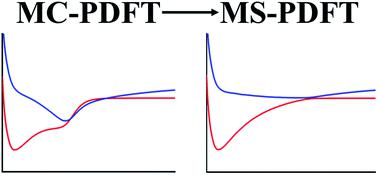当前位置:
X-MOL 学术
›
Faraday Discuss.
›
论文详情
Our official English website, www.x-mol.net, welcomes your feedback! (Note: you will need to create a separate account there.)
Multi-state pair-density functional theory.
Faraday Discussions ( IF 3.4 ) Pub Date : 2020-05-07 , DOI: 10.1039/d0fd00037j Jie J Bao 1 , Chen Zhou , Zoltan Varga , Siriluk Kanchanakungwankul , Laura Gagliardi , Donald G Truhlar
Faraday Discussions ( IF 3.4 ) Pub Date : 2020-05-07 , DOI: 10.1039/d0fd00037j Jie J Bao 1 , Chen Zhou , Zoltan Varga , Siriluk Kanchanakungwankul , Laura Gagliardi , Donald G Truhlar
Affiliation

|
Multi-configuration pair-density functional theory (MC-PDFT) has previously been applied successfully to carry out ground-state and excited-state calculations. However, because they include no interaction between electronic states, MC-PDFT calculations in which each state’s PDFT energy is calculated separately can give an unphysical double crossing of potential energy surfaces (PESs) in a region near a conical intersection. We have recently proposed state-interaction pair-density functional theory (SI-PDFT) to treat nearly degenerate states by creating a set of intermediate states with state interaction; although this method is successful, it is inconvenient because two SCF calculations and two sets of orbitals are required and because it puts the ground state on an unequal footing with the excited states. Here we propose two new methods, called extended-multi-state-PDFT (XMS-PDFT) and variational-multi-state-PDFT (VMS-PDFT), that generate the intermediate states in a balanced way with a single set of orbitals. The former uses the intermediate states proposed by Granovsky for extended multi-configuration quasi-degenerate perturbation theory (XMC-QDPT); the latter obtains the intermediate states by maximizing the sum of the MC-PDFT energies for the intermediate states. We also propose a Fourier series expansion to make the variational optimizations of the VMS-PDFT method convenient, and we implement this method (FMS-PDFT) both for conventional configuration-interaction solvers and for density-matrix-renormalization-group solvers. The new methods are tested for eight systems, exhibiting avoided crossings among two to six states. The FMS-PDFT method is successful for all cases for which it has been tested (all cases in this paper except O3 for which it was not tested), and XMS-PDFT is successful for all eight cases except the mixed-valence case. Since both XMS-PDFT and VMS-PDFT are less expensive than XMS-CASPT2, they will allow well-correlated calculations on much larger systems for which perturbation theory is unaffordable.
中文翻译:

多态对密度泛函理论。
多配置对密度泛函理论(MC-PDFT)先前已成功地应用于进行基态和激发态计算。但是,由于它们不包含电子状态之间的相互作用,因此分别计算每个状态的PDFT能量的MC-PDFT计算可以在圆锥形相交附近的区域中对势能面(PES)进行非物理的双重交叉。最近,我们提出了状态相互作用对密度函数理论(SI-PDFT),通过创建一组具有状态相互作用的中间状态来处理几乎退化的状态。尽管此方法是成功的,但它不方便,因为需要两次SCF计算和两组轨道,并且因为它会使基态与激发态处于不平等的地位。在这里,我们提出了两种新方法:称为扩展多状态PDFT(XMS-PDFT)和变分多状态PDFT(VMS-PDFT),它们以一组单独的轨道以平衡的方式生成中间状态。前者将Granovsky提出的中间态用于扩展的多配置准简并摄动理论(XMC-QDPT)。后者通过最大化中间状态的MC-PDFT能量之和来获得中间状态。我们还提出了傅里叶级数展开式,以简化VMS-PDFT方法的变式优化,并且我们针对传统的配置-相互作用求解器和密度矩阵-重新归一化组求解器都实现了此方法(FMS-PDFT)。新方法针对8个系统进行了测试,避免了2到6个状态之间的交叉。3个(未经测试),并且XMS-PDFT在除混合价案例之外的所有8个案例中均成功。由于XMS-PDFT和VMS-PDFT的价格都比XMS-CASPT2便宜,因此它们将允许在干扰理论无法承受的更大系统上进行良好相关的计算。
更新日期:2020-05-07
中文翻译:

多态对密度泛函理论。
多配置对密度泛函理论(MC-PDFT)先前已成功地应用于进行基态和激发态计算。但是,由于它们不包含电子状态之间的相互作用,因此分别计算每个状态的PDFT能量的MC-PDFT计算可以在圆锥形相交附近的区域中对势能面(PES)进行非物理的双重交叉。最近,我们提出了状态相互作用对密度函数理论(SI-PDFT),通过创建一组具有状态相互作用的中间状态来处理几乎退化的状态。尽管此方法是成功的,但它不方便,因为需要两次SCF计算和两组轨道,并且因为它会使基态与激发态处于不平等的地位。在这里,我们提出了两种新方法:称为扩展多状态PDFT(XMS-PDFT)和变分多状态PDFT(VMS-PDFT),它们以一组单独的轨道以平衡的方式生成中间状态。前者将Granovsky提出的中间态用于扩展的多配置准简并摄动理论(XMC-QDPT)。后者通过最大化中间状态的MC-PDFT能量之和来获得中间状态。我们还提出了傅里叶级数展开式,以简化VMS-PDFT方法的变式优化,并且我们针对传统的配置-相互作用求解器和密度矩阵-重新归一化组求解器都实现了此方法(FMS-PDFT)。新方法针对8个系统进行了测试,避免了2到6个状态之间的交叉。3个(未经测试),并且XMS-PDFT在除混合价案例之外的所有8个案例中均成功。由于XMS-PDFT和VMS-PDFT的价格都比XMS-CASPT2便宜,因此它们将允许在干扰理论无法承受的更大系统上进行良好相关的计算。



























 京公网安备 11010802027423号
京公网安备 11010802027423号